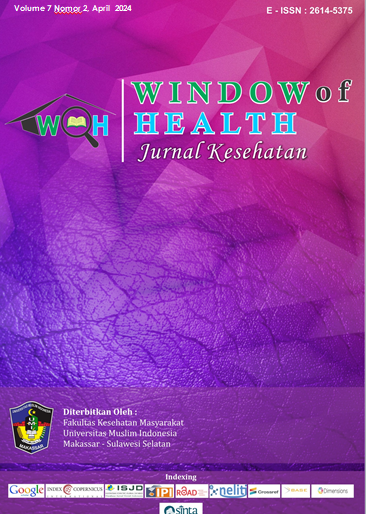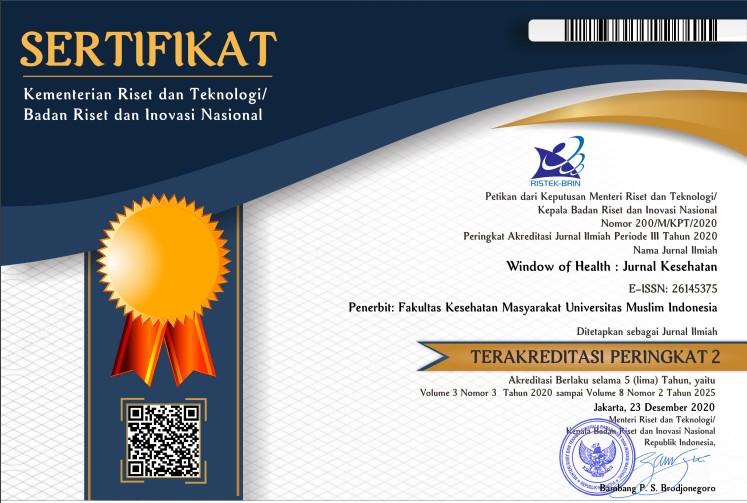The Antioxidant Effect of Ajwa Dates (Phoenix dactylifera L.) to Inhibit the Progression of Preeclampsia Threats on Pregnant Women through Malondialdehyde as Prooxidant Serum Marker
Abstract
Hypertension in pregnancy, including preeclampsia, is still a significant problem worldwide and is one of the top three causes of maternal death in Indonesia. The pathophysiology of the disease is unclear yet, but vascular dysfunction due to oxidative stress is thought to play a role. Ajwa dates are known for their antioxidant effects due to their higher phenolic and flavonoids than other dates. The study aimed to determine the impact of consuming seven Ajwa dates each day on the progression of preeclampsia as assessed by changes in malondialdehyde (MDA) levels. Forty pregnant women with gestational age more than 20 weeks were randomly assigned into two groups: the samples of the control group were 10, who were encouraged to consume lots of fruits and vegetables, and the samples of the intervention group were 30, who consumed seven pieces of Ajwa dates every day for eight weeks. MDA measurements were carried out pre-and post-intervention. The intervention group showed a significant reduction in MDA levels following the 8-week intervention period. Consumption of seven Ajwa dates every day can reduce MDA levels significantly and, thus, has the potential to inhibit the progression of preeclampsia in pregnant women who are at risk of preeclampsia based on stress oxidative mechanism.
References
WHO (World Health Organization). Maternal Mortality. 2023.
2. The American College of Obstetricians and Gynecologists. ACOG Practice Bulletin No. 203: Chronic Hypertension in Pregnancy. Obstetrics & Gynecology 2019;133(1):e26–e50; doi: 10.1097/AOG.0000000000003020.
Turbeville HR, Sasser JM. Preeclampsia beyond pregnancy: long-term consequences for mother and child. American Journal of Physiology-Renal Physiology 2020;318(6):F1315–F1326; doi: 10.1152/ajprenal.00071.2020.
Suprihatin E, Norontoko DA, Miadi M. Prediction of Preeclampsia by a Combination of Body Mass Index (BMI), Mean Arterial Pressure (MAP), and Roll Over Test (ROT). 2016.
D’Souza V, Rani A, Patil V, et al. Increased oxidative stress from early pregnancy in women who develop preeclampsia. Clin Exp Hypertens 2016;38(2):225–232; doi: 10.3109/10641963.2015.1081226.
Kulkarni A V, Mehendale SS, Yadav HR, et al. Circulating angiogenic factors and their association with birth outcomes in preeclampsia. Hypertension Research 2010;33(6):561–567; doi: 10.1038/hr.2010.31.
Mehendale S, Kilari A, Dangat K, et al. Fatty acids, antioxidants, and oxidative stress in pre‐eclampsia. International Journal of Gynecology & Obstetrics 2008;100(3):234–238; doi: 10.1016/j.ijgo.2007.08.011.
Hamad I, AbdElgawad H, Al Jaouni S, et al. Metabolic Analysis of Various Date Palm Fruit (Phoenix dactylifera L.) Cultivars from Saudi Arabia to Assess Their Nutritional Quality. Molecules 2015;20(8):13620–13641; doi: 10.3390/molecules200813620.
Eid NMS, Al-Awadi B, Vauzour D, et al. Effect of Cultivar Type and Ripening on the Polyphenol Content of Date Palm Fruit. J Agric Food Chem 2013;61(10):2453–2460; doi: 10.1021/jf303951e.
Nijveldt RJ, van Nood E, van Hoorn DE, et al. Flavonoids: a review of probable mechanisms of action and potential applications. Am J Clin Nutr 2001;74(4):418–425; doi: 10.1093/ajcn/74.4.418.
Panche AN, Diwan AD, Chandra SR. Flavonoids: an overview. J Nutr Sci 2016;5:e47; doi: 10.1017/jns.2016.41.
Kumar S, Pandey AK. Chemistry and Biological Activities of Flavonoids: An Overview. The Scientific World Journal 2013;2013:1–16; doi: 10.1155/2013/162750.
Malesev D, Kuntic V. Investigation of metal-flavonoid chelates and the determination of flavonoids via metal-flavonoid complexing reactions. Journal of the Serbian Chemical Society 2007;72(10):921–939; doi: 10.2298/JSC0710921M.
Procházková D, Boušová I, Wilhelmová N. Antioxidant and prooxidant properties of flavonoids. Fitoterapia 2011;82(4):513–523; doi: 10.1016/j.fitote.2011.01.018.
Khalid S, Khalid N, Khan RS, et al. A review on chemistry and pharmacology of Ajwa date fruit and pit. Trends Food Sci Technol 2017;63:60–69; doi: 10.1016/j.tifs.2017.02.009.
Soobrattee MA, Neergheen VS, Luximon-Ramma A, et al. Phenolics as potential antioxidant therapeutic agents: Mechanism and actions. Mutation Research/Fundamental and Molecular Mechanisms of Mutagenesis 2005;579(1–2):200–213; doi: 10.1016/j.mrfmmm.2005.03.023.
Achamrah N, Ditisheim A. Nutritional approach to preeclampsia prevention. Curr Opin Clin Nutr Metab Care 2018;21(3):168–173; doi: 10.1097/MCO.0000000000000462.
Copyright (c) 2024 Ida Royani , Nasrudin Andi Mappaware, Nur Rezki Nur Rezki, Suryani As’ad

This work is licensed under a Creative Commons Attribution-NonCommercial-ShareAlike 4.0 International License.








